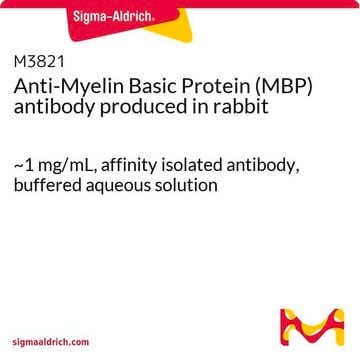N2912
Anti-Neurofilament 160/200 antibody, Mouse monoclonal
~2 mg/mL, clone RMdO20, purified from hybridoma cell culture
Sinonimo/i:
Anti-NEF3
About This Item
Prodotti consigliati
Origine biologica
mouse
Livello qualitativo
Coniugato
unconjugated
Forma dell’anticorpo
purified from hybridoma cell culture
Tipo di anticorpo
primary antibodies
Clone
RMdO20, monoclonal
Forma fisica
buffered aqueous solution
Reattività contro le specie
mouse, rat, human
Concentrazione
~2 mg/mL
tecniche
immunocytochemistry: suitable
immunohistochemistry: suitable
microarray: suitable
western blot: 1-2 μg/mL using extracts of rat brain S1 fraction.
Isotipo
IgG1
N° accesso UniProt
Condizioni di spedizione
dry ice
Temperatura di conservazione
−20°C
modifica post-traduzionali bersaglio
unmodified
Informazioni sul gene
human ... NEFH(4744) , NEFM(4741)
mouse ... Nefh(380684) , Nefm(18040)
rat ... Nefh(24587) , Nefm(24588)
Descrizione generale
Immunogeno
Applicazioni
Immunohistochemistry (1 paper)
Western Blotting (1 paper)
Stato fisico
Esclusione di responsabilità
Not finding the right product?
Try our Motore di ricerca dei prodotti.
Raccomandato
Codice della classe di stoccaggio
10 - Combustible liquids
Classe di pericolosità dell'acqua (WGK)
WGK 3
Punto d’infiammabilità (°F)
Not applicable
Punto d’infiammabilità (°C)
Not applicable
Dispositivi di protezione individuale
Eyeshields, Gloves, multi-purpose combination respirator cartridge (US)
Certificati d'analisi (COA)
Cerca il Certificati d'analisi (COA) digitando il numero di lotto/batch corrispondente. I numeri di lotto o di batch sono stampati sull'etichetta dei prodotti dopo la parola ‘Lotto’ o ‘Batch’.
Possiedi già questo prodotto?
I documenti relativi ai prodotti acquistati recentemente sono disponibili nell’Archivio dei documenti.
I clienti hanno visto anche
Il team dei nostri ricercatori vanta grande esperienza in tutte le aree della ricerca quali Life Science, scienza dei materiali, sintesi chimica, cromatografia, discipline analitiche, ecc..
Contatta l'Assistenza Tecnica.







